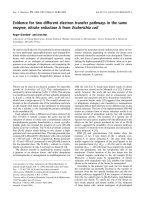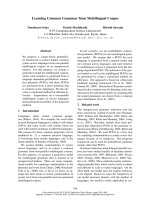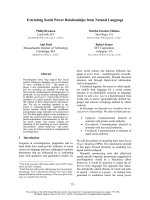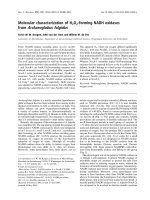Secrets From Innovation 10/2012 potx
Bạn đang xem bản rút gọn của tài liệu. Xem và tải ngay bản đầy đủ của tài liệu tại đây (2.57 MB, 155 trang )
Secrets from the I nnovation Room: How to Create High-Voltage I deas That Make Money, Win
Business, and Outw it the Competition
by Kay Allison
ISBN:0071443754
McGraw-Hill © 2005 (165 pages)
This thought-stimulating guide explains how the creative process is learnable, just like any other skill, and
debunks and replaces myths and mysteries with a step-by-step process for coming up with innovative,
hero-making, and profitable ideas on demand.
Table of Contents
Secrets From The Innovation Room—How to Create High-Voltage Ideas That Make Money, Win Business, and Outwit the
Competition
Introduction
Chapter 1
-
Defining The Undefinable
Chapter 2
-
Enemies Of Ideas and Innovation
Chapter 3
-
Asking Questions
Chapter 4
-
Releasing Potential Energy
Chapter 5
-
Open The Aperture
Chapter 6
-
Break The Board
Chapter 7
-
Measuring The Voltage
Index
List of Sidebars
Secrets from the I nnovation Room: How to Create High-Voltage I deas That Make Money, Win
Business, and Outw it the Competition
by Kay Allison
ISBN:0071443754
McGraw-Hill © 2005 (165 pages)
This thought-stimulating guide explains how the creative process is learnable, just like any other skill, and
debunks and replaces myths and mysteries with a step-by-step process for coming up with innovative,
hero-making, and profitable ideas on demand.
Table of Contents
Secrets From The Innovation Room—How to Create High-Voltage Ideas That Make Money, Win Business, and Outwit the
Competition
Introduction
Chapter 1
-
Defining The Undefinable
Chapter 2
-
Enemies Of Ideas and Innovation
Chapter 3
-
Asking Questions
Chapter 4
-
Releasing Potential Energy
Chapter 5
-
Open The Aperture
Chapter 6
-
Break The Board
Chapter 7
-
Measuring The Voltage
Index
List of Sidebars
Back Cover
Whether you believe it or not, you are naturally creative; the secret lies in knowing how to tap into your inner creativity.
Secrets from the Innovation Room takes the mystery out of the creative process, describing a new way of thinking you can
use to produce fresh, practical, money-making ideas guaranteed to revolutionize your firm’s strategies and products and
drive its growth.
Secrets from the Innovation Room details proven techniques for producing high-voltage concepts from your right brain,
then using your left brain to shape them into useful solutions. This thought-stimulating guidebook features:
The 10 Enemies of Innovation—how to recognize and avoid them
Brainstorming techniques for “graphing” proposals and ideas in order to evaluate which address the stated problem
and which fall by the wayside
Tangible steps for going beyond market research to determine what could be—and what you could do to help your
organization make it happen
A new innovation process for identifying valuable brand imagery and then for coming up with tangible product
features that bring it to life
Secrets from the Innovation Room shows you how to bring your natural creativity to the forefront by implementing a step-
by-step process for producing exceptional and profitable ideas—whenever, wherever, and “whyever” you need them.
About the Author
Kay Allison is founder of The Energy Annex, a marketing innovation and consulting firm that shows clients including Avon,
Kraft Foods, Nestlé, and others how to create new, revenue-generating ideas. Allison is the executive in residence for
Northwestern University’s graduate Integrated Marketing Communications program and has been quoted in leading
publications including the Los Angeles Times, I nvestor’s Business Daily, the Chicago Sun-Tim es, and the Econom ist.
Secrets From The Innovation Room-How to Create High-
Voltage Ideas That Make Money, Win Business, and
Outwit the Competition
Kay Allison
Art by David Buscher
McGraw-Hill
Copyright © 2005 by The McGraw-Hill Companies, Inc. All rights reserved. Printed in the United States of America.
Except as permitted under the United States Copyright Act of 1976, no part of this publication may be reproduced
or distributed in any form or by any means, or stored in a data base or retrieval system, without the prior written
permission of the publisher.
1 2 3 4 5 6 7 8 9 0 DOC/DOC 0 9 8 7 6 5 4
ISBN 0-07-144375-4
McGraw-Hill books are available at special quantity discounts to use as premiums and sales promotions, or for use
in corporate training programs. For more information, please write to the Director of Special Sales, Professional
Publishing, McGraw-Hill, Two Penn Plaza, New York, NY 10121-2298. Or contact your local bookstore.
This book is printed on recycled, acid-free paper containing a minimum of 50% recycled, de-inked fiber.
Library of Congress Cataloging-in-Publication Data
Allison, Kay.
Secrets from the innovation room : how to create high-voltage ideas that make money, win business, and outwit the
competition / by Kay Allison.p. cm.
ISBN 0-07-144375-4 (pbk. : alk. paper)1. Creative ability in business. 2. Organizational effectiveness. 3. Success in
business. I. Title.
HD53.A423 2004658.4'063-dc22
2004012342
Acknowledgments
I would like to acknowledge and thank the following people who have inspired, encouraged, and supported me in
creating this book:
John Donicht, my husband and business partner, for his unflagging encouragement, love, and consistency.
You make my dreams and ideas become reality. This book is proof.
Claire, Christian, and Anya, my darling, beautiful, playful children whom I adore.
To my clients, who encourage me and expect me to experiment and grow.
Dan Sullivan, my business coach, who gave me the tools to package my intellectual capital and the community
that made sure it happened.
My Coach2 buddies, who keep me on track and challenge me to keep up.
Robert Stuberg, Rob Hart, and David Buscher, who are packagers extraordinaire.
My students at Northwestern University, who were an engaging and challenging audience as I developed this
material.
Sensei Jeff Kohn, who challenged me to break my first board at my black belt test and who has challenged and
coached hundreds of my clients and students to do the same since.
To my creative inspirations: Natalie Goldberg, Laurie Beth Johns, Jean Houston, SARK, Julio Ollala, and John
Kao.
My sisters, Jan and Sue, and my mom and dad, Bev and Clare, for setting me up to be highly ambitious.
To my vigilant and encouraging editors: Kelli Christiansen and Janice Race. Thanks for guiding this newbie
through the process.
About The Author
Kay Allison is founder of The Energy Annex, a marketing innovation and consulting firm that shows clients including
Avon, Kraft Foods, Nestlé, and others how to create new, revenue-generating ideas. Allison is the executive in
residence for Northwestern University's graduate Integrated Marketing Communications program and has been
quoted in leading publications including the Los Angeles Times, Investor's Business Daily, the Chicago Sun-Times,
and the Economist.
Introduction
My name is Kay Allison, and I make my living by helping people have ideas.
Many people I've worked with consider themselves to be intelligent, well educated, and open to new ways of
working, yet when they are faced with the prospect of having to generate new ideas, they say with resignation, 'Oh,
I'm not creative.' Creative people have new ideas all the time, right? New concepts spring fully formed from their
heads with ease. 'I can't do that!' people insist.
Why is the creative process such a mystery? Why are we so quick to believe that creativity is magical, a talent that
very few are given? It's easier to stand back, to let other people-the ones who are creative- have the ideas.
One of the first things I tell my clients is that I didn't start out as a creative person. I didn't believe I was creative at
all.
My older sister, Jan, was an artist. I was not. She had the idea of creating artwork on the cement walls of the
basement of our house in a suburb outside of Chicago. On one side of the basement, she painted a series of
panels; each had a piece of poetry surrounded by beautiful images, each in a distinctly different style from the
others.
After I saw what Jan had done, I couldn't wait to try it myself. I badgered my parents into giving me a part of the
basement to paint. My side of the basement had a single wall . . . and I couldn't come up with a single idea.
I kept looking at Jan's work and wondering what I should do. Other thoughts kept creeping in: Was I good enough
to do this? Would my wall be as good at hers? Where should I start? How could I make my wall as cool as hers but
different enough to reflect my own personality?
Without a plan in mind, I began painting. I painted 'Kay's Place' at the top of the wall, and under the title I painted
my garden. It came out as a wall of dorky-looking flowers. They were boxy and amateurish, with thick stems and no
perspective. I looked at my painting and thought, 'I'm a failure. I can't do this. I never should have tried. I'll never be
as creative as Jan.'
I tried many things (singing, acting, playing the cello), diving into each with a great deal of enthusiasm and a
modicum of talent.
However, despite my energetic attempts, nothing I tried led to success. I had to be realistic and realize that I wasn't
going to earn my living as a singer, an actor, or a cellist. So, I went into advertising. In advertising agencies, there is
a department of people who are called 'creatives.' I was not in it.
Clearly, I wasn't creative; I didn't have the title. And yet I kept being asked to have ideas, and to have them fast.
'You're Looking In The Wrong Places'
When I had been working at a big ad agency for a year, an executive at an international Fortune 500 company
asked me to write a presentation on how to market 'mature' brands. This guy worked in the floor wax category. With
more women working and the rise of no-wax flooring, this guy's business was tanking fast. Here I was, labeled
'uncreative,' but expected to produce ideas that had enough power to stanch the losses this guy was facing. There
was a lot on the line here. This client's career would be affected. His company's profits and stock price would be
affected. My agency's relationship with this client would be affected. And, not least, my career would be affected.
I asked my bosses, 'What do I do? Where do I start?' They directed me to look at examples in other packaged
goods categories and to learn lessons from other people's experiences. I remember gathering all kinds of
information-case histories, consumer surveys, videotapes of other people's advertising. I worked lots of hours.
Then I went back and showed my bosses what I was doing.
'You're looking in the wrong places,' one of them told me. 'Well, where should I look?' I asked. 'Just keep working.
Ask the Information Center for more articles.'
I raised my eyebrows, asked for more articles, stayed late. I wrote some kind of presentation that showed what
companies in similar positions had done. Then I drove to another state to make my presentation to my client. I
explained what had worked for lots of other companies, but the client kept asking me, 'So what does this mean for
me?' and 'Now what should we do?' He was interested in something more revolutionary than what I'd given him. He
wasn't interested in the lessons of the past; he wanted to know how to get to the next revolution.
What I remember most about the presentation was not being able to help my client create the kind of ideas that
would drive sales, revolutionize his category, and connect with consumers in a new and powerful way. Copying
other people was not going to enable me to answer my client's questions.
I survived that presentation, but it left me with some burning, basic questions: What makes an idea a good idea?
How do you consistently generate good ideas? How do you find that magic 'x factor' that makes an idea stand out?
My entire career, from director of new business development to innovation consultant, has been focused on the
answers to those questions. I have been on a quest for ideas, a search for the source of creativity. Not in some
abstract, vague sense; I knew there had to be a way of thinking that led to good, new, fresh, practical ideas. And I
was on a quest to find out what it was.
So Why This Book?
As you hold this book in your hands, you can tell that it looks different and feels different from most of the other
books you've probably run across on this subject.
This is a book about thinking in new ways, but it's also a book about action. I'm going to ask you to do things: Carry
the book around with you; draw on the pages (I've left room for sketches and notes and bursts of inspiration); rip
the pages out. There's no magic list of answers that you can find by flipping to the back of the book. I can suggest
the steps for you to take. You have to commit to actually taking them.
You see, I've learned that just thinking about a problem may not be enough to develop a creative solution.
Throughout this book, I've created experiences that, if you participate in them, are opportunities for you to have
powerful, high-voltage ideas that will have the power to rock your world.
Most people don't think they can have ideas that will change things. I know I sure didn't think of myself as creative.
The fact that, after my initial failures at being creative, I've found a way to produce high-voltage ideas on a
consistent basis tells you that there is hope.
One of the things that has most inspired my search for creative solutions is an idea I got from one of my most
influential teachers, Dan Sullivan of The Strategic Coach. Dan says that we have a fundamental choice in every
situation: We can create, or we can complain. Think about that for a moment, and then make a choice about how
you'll approach each challenging situation in the future.
Creativity is applicable in more than just the business world. This book will show you-if you make the choice to
create rather than to complain-how to generate ideas that can and will change things for the better.
Let's get started.
Exercise
Describing Creativity
What do you think of creativity? Right now, before you begin a book dedicated to the topic, it's time to get to the
heart of your current beliefs. Consider it a gauge that pinpoints the starting point of your journey.
On the back of the page, write or draw everything you really believe about creative people. Do you think they're
geniuses? Airy-fairy? Impractical? Inspirational? Weird? Powerful? Wear too much black? Be as detailed as you
possibly can, and get it all out!
When you've written everything you can, examine the list carefully. Where did those ideas come from? Are they
grounded in your experience? Something you saw on television? How attached are you to these beliefs?
What's Going On Here ¿
A person's attitude toward creativity is one of the chief factors that determine whether he or she is able to tap
into it. How many of the beliefs you listed may actually keep you from accessing your own creativity, either
because they don't seem worthwhile, or because they seem like something beyond what ordinary you can
aspire to?
Consider your descriptions again. Would they match Thomas Edison? Benjamin Franklin? Ghandi? Steve
Jobs? Queen Elizabeth the First? These are all deeply creative people who used those abilities to change the
world.
You just finished the first of many experimental exercises you'll find in this book. Please complete each one as you
come to it, and don't read any further until you've done so. Each exercise is carefully designed to help you
understand new ideas instinctively and emotionally, not just intellectually.
Chapter 1: Defining The Undefinable
Overview
Let's analyze creativity.
That's a joke, right? People talk a lot about 'creativity,' but what exactly does that mean? The dictionary gives a
straightforward definition: the ability to be original, to imagine new things and new ideas.
Businesses thirst for new ideas and always claim to be on the lookout for creative solutions to problems-you don't
see anyone using the tagline 'We Do Things the Old, Boring Way.' Creativity in today's business world means
coming up with ideas that make money, win business, and make the competition shake in its boots-ideas that have
equal measures of uniqueness and relevance. The problem is that most good businesspeople are trained to be
analysts: Analyze the consumer demographics, analyze your sales data, analyze the performance of your
competitors. Obviously, there is great value in being smart about your business-in knowing to whom you're selling
and how much they're buying.
However, analysis can only set the stage for innovation. A creative solution can't be analyzed into existence.
Brilliant ideas seem obvious only after the fact-once someone has a great idea, then all the analysts can tell you
exactly why it's a great idea. But the process doesn't work backwards; all the data in the world can't spontaneously
produce a new idea.
To be creative is to reach out into the unknown, to imagine something that doesn't currently exist. That implies risk,
and if you're a good businessperson, you're rightly suspicious of risk. Organizations thrive on numbers, on proof,
on hard facts. New ideas are simultaneously desired and feared. We all want them-but where are they? How do we
uncover them? Why do some businesses seem to be innovation machines? It's easy to see a good idea once it
already exists, and it's easier in hindsight to see an opportunity once it's already been exploited. What's hard is
developing a process that identifies opportunities and generates ideas on a consistent basis. That's what this book
is dedicated to providing for you.
You could define insanity as 'doing the same thing over and over and expecting a different result.' Everywhere I
looked, I saw companies doing just that: trying something that was successful in the past and expecting to get
something new out of the process.
Exercise
Where Do You Get Your Ideas?
Despite the provocative question on the previous page, this exercise is not really going to tell you if you're insane.
(The most I can help you there is to repeat what a friend once told me: 'If you think you are, you probably aren't.' Or
was that the other way around!) But this will help illustrate your style of approaching new problems.
Imagine you've been hired to create a new brand of tennis shoe and given absolute freedom to do anything you
want. Right now, before you read any further, use the space on this page to roughly sketch its appearance and list
its features.
What's Going On Here ¿
What was the first thing you did when faced with this problem? Did you think about the sneakers you already
own? List categories of shoes and work within those? Picture existing brands and duplicate their styles and
innovations?
Or did you try to look at the sneaker in a new way? Imagine a new demographic, or try to figure out what an
existing demo- graphic wants and isn't getting? Devise features no sneaker has had before?
When you look to the past for the solutions to problems like this, or if your starting point is to accept the
parameters of what's already been done to solve them, you limit your potential for innovation.
Left Brain, Right Brain
If you're interested in creativity, then you've probably been exposed to the concept of 'left-brain' and 'right-brain'
thinking.
The theory grew out of the work of Nobel Prize-winning psychobiologist Roger Sperry, whose study of epileptic
patients showed that each hemisphere of the brain processed different types of information. Broadly put, the left
brain is the objective, analytical, logical half of the brain, looking at information sequentially and focusing on
individual parts rather than on the whole (remember left = logical). The right brain, on the other hand, is the
subjective, intuitive, playful part of the brain; it looks at information in a more random fashion, seeing the whole
rather than the parts.
The 'voilà!' moments of innovation come from the right brain: You suddenly see how unrelated things connect; you
see a new solution to a problem; you are struck by a new idea from out of nowhere. Monumental discoveries from
penicillin to nylon to X rays were all made by accident-through the serendipitous flashes of insight that come from
the right hemisphere.
But once you have that insight, what do you do with it? Here's where the left brain comes into play, giving concrete
form and shape to the right-brain-inspired concepts.
If you're reading this book, it's a good bet that you are more comfortable operating in your left brain than in your
right brain. The exercises throughout the book are designed to get your right brain activated: Rather than sit and
wait for 'inspiration' to strike, you can prime the pump and get the ideas flowing. Once you have the raw material
(concepts and ideas), you can let the left brain do its thing and start editing and planning.
It's important for you to remember that you can't simultaneously be in 'idea-generation mode' and in
'editing/analyzing mode.' One has to follow the other.
What this means is that when you're doing the various exercises in this book, you will be sorely tempted to analyze
the experience as you are going through it. 'Am I doing it right? Is this what's supposed to be happening? How do I
know if it's working?'
In order to access your right brain with any success, you have to do your utmost to keep your analytical brain from
kicking in until after you're done with the exercise.
There are explanations of why and how the exercises function and the kinds of results they can have (to satisfy the
logical cravings of the left brain). But in the end, they are all trying to accomplish the same thing: to stimulate the
right brain, the source of inspiration.
Exercise
A Mental Picture Of Your Brain
Close your eyes and summon up a visual image of the right side of your brain.
Then do the same for the left side.
Quickly sketch the image that you see. Go with the first thing that comes to mind. Don't overthink.
When I first did this exercise, I saw my right brain as a mountainside meadow filled with wildflowers and people
dancing and singing.
I saw my left brain as walls lined with steel shelves. There was a steel trap on one of them, but it was covered with
dust.
Nowadays, my left brain is neater and cleaner . . . but the first image is telling, isn't it?
Exercise
Soliloquy
A soliloquy is a monologue in which someone gives voice to his or her deep feelings. Shakespeare used this
device a lot in his plays: one of the most famous begins, 'To be or not to be. . . .' In this exercise, continuing the
process of getting in touch with your existing beliefs about creativity, you're going to give voice to the right side of
your brain, the part associated with creativity and intuition.
Fill in the following blanks as you believe your right brain would. Have fun, lighten up, and write down whatever
comes to you. Don't censor yourself.
I am the spirit of
I have traveled
I have met
I have conquered
I have learned
I have tried and failed
I am stuck on
I yearn for
What's Going On Here ¿
What is your creativity trying to tell you? Is it anxious to be accessed and harnessed as a helpful force in your
career and in you life? Is it afraid of you? Has it atrophied from neglect? Does it have a secret you don't know
about? People are often surprised by what their right brain is trying to tell them- and listening is a great way to
begin this journey.
Logic Versus Energy
We all know a good idea when we see it. A good idea grips you. There's an immediate gut reaction, a zing that
makes you feel inside like, 'Yes, of course! That's right. That's cool. I want that.'
A zingy idea gets your attention. Ideas like that have voltage, energy, life. They have the energy to make you
different. They have the power to change your mind, your imagination, even your actions. They have the oomph to
change your company or your industry.
A good idea is relevant to your life. It resonates with you . . . and yet it's different enough that it didn't occur to you
before. No matter what the idea or innovation, if it's great enough to change you, it has that magic combination of
relevance and difference.
I've sat through too many meetings where the people in charge approved the idea that made sense rather than the
idea that got a reaction from the room. In meeting rooms all over America right now, managers are arguing for the
'make sense' ideas rather than the ideas with a spark of energy. In fact, the truth is that the worst idea is the one
that makes sense. If you're not excited and energized by your idea, what consumer is going to be?
This is another instance of the left brain (logic) triumphing over the right brain (intuition). The majority of us live in
our left brain. We've been trained to be logical people. Obviously, there's value in logic-at the right time. When it
comes to innovation, the role of logic is to sort and strategize rather than to generate. Ideas that don't elicit a
reaction in a meeting room are unlikely to generate a reaction in the marketplace.
Reason has a role in the innovation process; it's just not operative at the beginning. John Kao and Dorothy Leonard
at Harvard Business School teach that the process of innovation can be thought of as a diamond shape: It has a
divergent and a convergent side.
The divergent top of the process is driven by emotion and energy (right-brain qualities); the convergent part of the
process is driven more by logic, as the left brain comes back into play. Many of my clients are much more
comfortable in the convergent part of the process than in the divergent part. The divergent part can feel
uncomfortable, and that's OK. Just stay there for an hour or a day longer than you're used to, and you may be
amazed at what creative genius steps forward. We need to let our logical minds take a rest on the hammock for a
little while we're working early on (just as I've asked you to do with the exercises in this book).
When we let go of logic for a moment, we can be open to ideas that might not 'make sense,' but that get a reaction.
We've all been in meetings where people react strongly to something-perhaps with a laugh, an inadvertent 'mmm . .
. ,' scorn, anger, the hair on the back of the neck going up. Usually those ideas are the ones that get discarded and
discounted.
Those are the ideas with energy. They've elicited a reaction. Some nugget in that comment may have the potential
to elicit a reaction in the marketplace as well.
Do you always want to run with the raw 'mmm . . . ' idea? Of course not. This is where our logical minds help us
out. We can take the basic, unfiltered ideas that emerge during the divergent phase of thinking and use our logical
minds to shape them and mold them.
Energy is important. You can find energy by looking for paradox, conflict, and friction. When you find those 'hot
spots,' you know that you've found a source of energy. That's fertile territory in which to start drilling, exploring, and
generating ideas.
All of the innovations that have had the power to change my life have in some way given me a fresh way to resolve
a paradox I'd been living with. For example, when I was a single, working mom, I wanted to hire other people to do
stuff for me as much as possible (who has the time or the energy for an expedition to the grocery store every
week?), and yet my kids are picky, and I'm fussy. I want it done my way.
Then Peapod introduced an online grocery shopping and delivery service that was personalized to my needs. I
could order all my groceries-and specify that I wanted bananas that were really ripe-and the next day they were
delivered to my third-floor walk-up condo. Everything was just the way I wanted it, yet I didn't have to do it myself.
Peapod is a great resolution of conflicting desires.
I'll use various examples throughout this book, but I don't necessarily believe in studying case histories in minute
detail. That path leads to my fledgling 'this is the way everyone else has done it' floor wax presentation.
Everywhere in our culture-in the marketplace, on television, in the movies-you can see examples of imitation
substituting for innovation. Carefully putting your feet into someone else's footsteps is not the same as learning
how to walk.
Instead, we're going to look beneath the surface, at the process of thinking creatively-and at the ways in which we
often stop ourselves from thinking this way.
This book will help you have ideas that work because they grip people. The opportunities for having ideas that work
are all around us every day. They come out of the stuff of life; they don't come from mad scientists with test tubes
shut up in labs all day long. We all have situations that we accept with a shrug and a feeling that 'that's just the way
life is.' These are the situations in which we can choose to complain or to create. They are fertile territory for
powerful ideas.
Chapter 2: Enemies Of Ideas and Innovation
Overview
If we were all fully capable of inventing novel solutions to every challenge we faced, all of our problems would be
solved quickly. What I've found is that we're all held back to some degree by enemies of ideas. In this chapter, we
will explore some simple ways to stop these enemies in their tracks before they shut us down completely.
'Of course,' you say to yourself, 'I have good ideas. I'm a creative problem solver. I'm open-minded. I'm not like
those cartoon middle managers who hide in cubicles and squash any new ideas that cross their desks. No, I want
to break boundaries, push the envelope.
'But-
Everybody wants to be innovative. Nobody wants to be known as the guy who said that the lightbulb was a bad
idea that would never work. The tricky thing about the enemies of ideas, though, is that you can't always recognize
them.
It's ironic that many patterns of behavior and modes of thinking that work well in performing certain structured
activities (test taking, for example) only get in the way when we try to use them to come up with new ideas. We're
taught from an early age to know the right answer, to be polite, to be sensible, to stick with the tried and true, to try
harder. It's not so easy to abandon the behaviors that we know to be 'right.'
The tools and techniques that many companies employ provide an exquisitely sophisticated snapshot of what is;
however, those same tools and techniques simply don't work to show what could be. Many companies rely on
expensive and exquisitely detailed reports that show every nuance of brand sales, product usage, brand-switching
behavior, cost sensitivity, and so on. What these reports don't show is how the power of an idea could change
things.
In my work, I've encountered the same enemies of ideas over and over. Some of them turn up everywhere, while
others seem more specific to particular organizations. In the pages that follow, we'll look at the ten most prevalent
enemies of ideas that I've experienced.
The first step to eliminating these barriers is to recognize them. Which ones are most present in your work? In your
life?
This is a big one, but it's a hard one to admit to. No one is willing to own up to being afraid. Cautious, prudent,
perhaps even conservative, but not afraid. In the corporate world, admitting fear is tantamount to admitting failure.
It's just not done.
But the fear is there, even if it's well disguised. We all remember only too well the feeling of being in front of the
class and making some kind of mistake. Your face reddens; your adrenaline starts pumping; you feel sweat
trickling down the back of your neck. It's not an experience that anyone wants to repeat.
We go through elementary school, high school, college, graduate school, and up through the ranks of companies,
always with an authority figure that we have to please. Even CEOs have to answer to Wall Street. And underneath
our well-coordinated businesswear, somewhere there's a fourth grader who has resolved never to look stupid in
class again.
Maybe you don't call it fear; how about anxiety? Apprehension? Stress? Worry? When you don't feel secure in a
situation, you won't allow yourself to risk. You can imagine pitching a new idea to your colleagues, clients, or
supervisors and getting the eye roll, the puzzled look, the dismissive comment ('interesting, but not what we're
going for here').
Fear is paralyzing. The fear of being judged, of looking stupid, of being wrong, of failing, of taking the blame-it's
lurking just beneath the surface, in the clever disguise of caution. When you can't put the full force of your
enthusiasm and passion behind a new idea, that idea will be dead on arrival.
One thing I've learned is that whatever I focus on grows. So if I focus on the anxiety that gnaws in my belly, it gets
so big that it's paralyzing. On the other hand, if I focus on what my next appropriate action should be, it gets me
into motion.
Exercise
What Are You Afraid Of?
This is a very important exercise. Cover this page with a list of what you're afraid of. Rational, irrational, it doesn't
matter. This is the place to let your fears loose. Get them all out. Use the back of the page. Study each one
carefully, because it may lead you to others.
Exercise
What Would You Do?
On this page, make a list of all the actions you would take if you didn't have the fears you just listed. What would
you do if you could set aside those fears for a moment? If I told you to borrow my faith that it will all work out, what
action could you take today?
What's Going On Here ¿
You'll find that most of these enemies of ideas and innovation, no matter what they're called, are about fear-
fear of how you'll look to others, fear of embracing the unknown, fear of looking at the world through unfamiliar
eyes. Fear is insidious and will always seek to hold you back. Your personal fears are nurtured by your
unwillingness to face them or even to name them. This exercise can be the first step in examining your fears
and their inevitable consequences, and the first step to overcoming them.
All of us, especially those of us who are ambitious and driven, are used to advancing our own point of view. We
have a particular way of seeing things, and the more focused and specific that vision is, the more successful we
are.
This kind of mindset can work brilliantly in a debate, but it doesn't serve you as well when you're trying to see fresh
solutions to issues or opportunities. From any one perspective, you can see only 180 degrees of the world. What
you need is to see the full 360.
It's easy to forget that there are many people involved in any business transaction, all of whom have different
needs and opinions. If you can shift your point of view and get inside the skin of someone else-your consumer,
your supplier, the guy from R&D-you'll be able to dramatically expand the number of possibilities that you can see.
There is the hidden fallacy that if you can somehow push your own particular point of view, amplify it, and make it
loud enough, everyone will fall into line. If you consider any monopoly (The Ford Motor Company back in the day of
the Model T, for instance), you'll find this mode of thinking: You can have a car in any color, as long as it's black. A
one- size-fits-all approach dismisses the validity of any alternative opinions.
This may seem obvious when you think about extremes (for example, a dictatorship versus an open society), but it
can be hard to spot in yourself. When you're thinking about a particular problem, really peel away the assumptions
you're making. 'We don't need to make cars in different colors. Nobody cares what the car looks like-it's a utilitarian
appliance. All people want is to get from one place to the other.'
Closely related to this way of thinking is, 'We've always done it this way' (see Enemy Seven). Sometimes you need
to ask yourself, 'If I were going into business to compete with my own company, where would I start? Whose needs
are we not serving? Why do people prefer this feature in my category? Why is that important to them? How does it
fit into the rest of their lives?'
The Wright brothers, inventors of the first successful heavier-than-air craft, took nothing at face value. Every
inventor who was working on building an airplane at that time was re- lying on the same tables of aeronautical data
that had been compiled by an earlier pioneer in the field. The Wrights challenged conventional thinking and began
from scratch, questioning every assumption that their predecessors had made.
When they were trying to solve a problem, the brothers would each take one side and fiercely debate the issue,
then they would change sides and argue the opposite viewpoint just as vigorously. They tested every theory this
way, ensuring that they saw every issue from every angle.
To a conventional thinker, it may seem that conceding the existence of opposing views will weaken your own
convictions. Paradoxically, the ability to see many sides of a situation allows you to come up with the most viable
solutions. Adopt a diplomat's mindset: What is the person on the opposite side of the table thinking? What can you
learn from that person?
Exercise
Get To Know Someone
My friend Teresa Easler asks her clients to write a list of everything they know about the person they're
communicating with, including a list of the things that they can appreciate about that person. After all, the person is
someone's child, brother, friend. Think about someone in your company, about your competition, about your
customers.
What's their background? What's their history?
What's important to them? Why are they at this meeting?
What motivates them?
What's missing for them?
What are their hopes and fears?
Most of us write down the logical things that are said in meetings: 'That seems like the sensible course of action.'
There are always ideas that seem perfectly rational, seem to solve the problem at hand, and yet have no 'spark' in
them. They are the equivalent of middle-of-the-road political candidates: They satisfy all the basic requirements,
but they won't get anyone up out of their chair to go to the polls.
How many times have you seen a movie (or even a 'coming attractions' trailer for a movie) and realized that you
know exactly how everything will turn out? A leads to B leads to C . . . all the necessary plot points are covered (car
chase! love scene! heart-tugging ending!), and the movie unspools in a completely predictable fashion. Everything
makes sense, but nothing is exciting. The best moments come when something unexpected enters the story-not
something completely random, but a twist, a jolt that pushes the action out of the predictable.
In a meeting, the 'logical' idea is often one that can be completely understood immediately. You know how
everything will turn out. There are no surprises. The idea with energy behind it is often a surprise-and it gets a
reaction.
You can see how listening for logic easily goes hand-in-hand with the first enemy of innovation, giving in to fear. If
you're looking for no risk, then every idea should be rational, by-the-numbers, and completely unsurprising. If
you're only listening for logic, then any idea that's new can immediately be picked apart and found to be
unworkable (many times, we'll do this in our heads before a new idea has a chance to make it out into the room).
When you're listening for energy, write down the thing that makes the room react. What makes people laugh?
Groan? Get angry?
Write down all the ideas with colored pencils, markers, or crayons. Tepid ideas get tepid colors; energetic ideas get
written down in big, bold letters. Draw circles around them; decorate them with stars; follow them with exclamation
points! The ideas that make a stir in the meeting room have a nugget of energy that will get a reaction from your
customers as well.
The secret of listening for energy is having the patience to figure out how to make the energetic ideas doable. It
requires being able to engage in 'what-ifs' without dismissing anything as impossible.
Hold on to those ideas that spark a reaction, even if it's not immediately clear how they can be put into practice.
How can we expect to get a reaction from the marketplace when we can't get a reaction from our team?
This brings us back to the idea of left-brain-right-brain cooperation. Use the right brain to make the 'leaps of logic'
that generate ideas, and use the left brain to find a way to make those ideas work. One side supplies the raw
material; the other side edits, shapes, and polishes. Just don't try to make the left brain do the right brain's work.
Let energy come first, then use logic.









